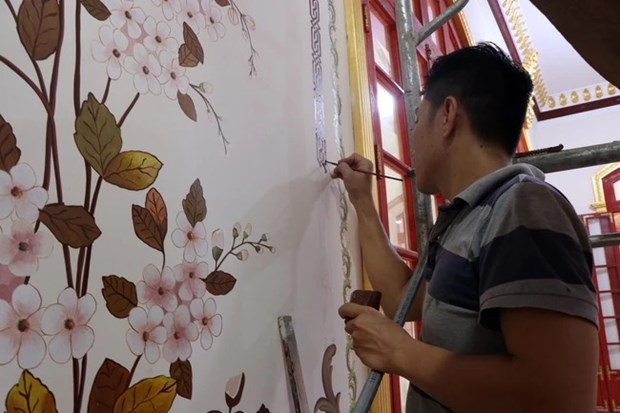
A highlight of Kiến Trung Palace is the unique decoration of traditional porcelain patterns. — VNA/VNS Photo Đỗ Trưởng
HUẾ CITY — The restoration of Kiến Trung Palace which housed the last Vietnamese emperor in the Huế Imperial Citadel will be finished by the end of this year, according to the Huế Monuments Conservation Centre (HMCC).
The work began in February 2019 and has entered the final phase. It will help preserve and uphold the UNESCO-recognised Complex of Huế Monuments in the central province of Thừa Thiên-Huế, the centre said.
Kiến Trung Palace was built between 1921 and 1923 during the reign of Emporer Khải Định (1885-1925) and served as the living and working space of Bảo Đại, the last emperor of the Nguyễn Dynasty which reined from 1802 to 1945.
The palace is an important historical work, marking a unique and special period that complements the traditional Huế royal design.
Its architecture meets the characteristics of an Indochina-style building with a combination of Asian and European influences. It incorporates elements from three distinct architectural styles - traditional Vietnamese, French and Italian Renaissance - and embodies an era of Western influence in Việt Nam.
It is among the five main palaces of the former royal citadel, along with Thái Hòa, Cần Chánh, Càn Thành, and Khôn Thái. In 1947, the palace was practically destroyed by the war with only its foundations remaining intact.
Investments in the reconstruction of Kiến Trung Palace were significant to rebuild the foundation walls, railing system, front and back yards, and two floors with a height of about 14m, on a construction site of about 975sq.m.
Other small works such as brick pedestals, fountains, cannons, guard houses, and gardens are also part of the investment plan.
The highlight of Kiến Trung Palace lies in the unique colourful patterns inlaid with porcelain in vivid decorative themes to create the soul of the work. The restoration of the porcelain mosaic is about 80 per cent complete and has involved the participation of many skilled and experienced artisans in the field of folk art.
Artisans are meticulously working on the basis of ancient documents about the architecture of the palace in an effort to bring back all original decorative motifs on its walls and ceilings. Currently, the main work on reinforcing the concrete structure has been completed. The roof has been covered by royal glazed tiles and the upper part decorated with animal features.
After completion, the work is expected to create a new attraction for domestic and international tourists when coming to Huế Imperial Palace.

An artist works on a wall decoration in the palace. The work which began in February 2019 now has entered its final phase. — VNA/VNS Photo Đỗ Trưởng
Thừa Thiên-Huế is the only province in Việt Nam and Southeast Asia to be home to five UNESCO-recognised cultural heritages. They are the Complex of Huế Monuments, nhã nhạc (royal music), the woodblocks of the Nguyễn Dynasty, documents of the Nguyễn Dynasty, and the royal literature on Huế Royal Architecture.
Since its UNESCO recognition in 1993, the Complex of Huế Monuments has gone through preservation to develop it sustainably. Huế City authorities and the HMCC have been working on dossiers to restore the Cần Chánh Palace and Đại Cung Môn (Great Palace Gate). — VNS
OVietnam